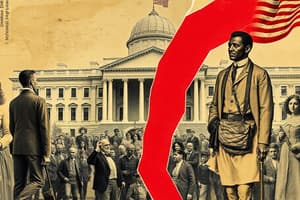Podcast
Questions and Answers
The founding fathers created a system of government with four branches instead of three.
The founding fathers created a system of government with four branches instead of three.
False (B)
The legislative branch is described in Article 1 of the US Constitution.
The legislative branch is described in Article 1 of the US Constitution.
True (A)
The executive branch is led by the Vice President according to the US Constitution.
The executive branch is led by the Vice President according to the US Constitution.
False (B)
The elastic clause in the US Constitution allows the powers of Congress to shrink over time.
The elastic clause in the US Constitution allows the powers of Congress to shrink over time.
The President is not involved in appointing ambassadors according to the US Constitution.
The President is not involved in appointing ambassadors according to the US Constitution.
The Supreme Court's main role is to create laws.
The Supreme Court's main role is to create laws.
If a bill gets more than 50% of the votes in both the House of Representatives and the Senate, it will automatically become a law.
If a bill gets more than 50% of the votes in both the House of Representatives and the Senate, it will automatically become a law.
The President can veto a bill to ensure it becomes a law.
The President can veto a bill to ensure it becomes a law.
The Supreme Court does not have the power to decide if a law is constitutional.
The Supreme Court does not have the power to decide if a law is constitutional.
The system where the three branches of government check on each other is known as separation of powers.
The system where the three branches of government check on each other is known as separation of powers.
Flashcards are hidden until you start studying


